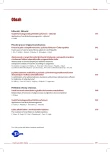From the diagnosis of celiac disease to the prospect of legislative changes
Authors:
Peter Makovický 1; Pavol Makovický 2
Authors‘ workplace:
Department of Veterinary Sciences, Czech University of Life Sciences, Praha, vedoucí katedry doc. MVDr. Radko Rajmon, Ph. D.
1; Katedra špeciálnej zootechniky Slovenskej poľnohospodárskej univerzity Nitra, Slovenská republika, vedúci katedry prof. Ing. Ondrej Debrecéni, CSc.
2
Published in:
Vnitř Lék 2009; 55(6): 583-586
Category:
Forum
Overview
Celiac disease is diagnosed in children as well as adults. For long now, this has not been a rare diagnosis. Publications by local authors have warned, as early as 1990ies, that this disease is extremely under-diagnosed, as confirmed by current clinical practice. Despite this, it is evident that the prevalence of this disease in Slovakia and the Czech Republic is high. Currently, it is assumed that the traditional symptomatic form of the disease represents just a fraction of the overall prevalence. As a consequence to the gradual introduction of the disease screening and the efforts of the medical community to diagnose the disease in its early stages, the disease is now thought of in a surgery of a first-contact physician as well as in a specialist surgery. Continually increasing number of diagnosed patients leads to increasing demands related to their needs. Strict gluten‑free diet is the only available causal therapy. Gluten‑free products are marked with a universally recognised international symbol – crossed-out grain spike – or are labelled “gluten‑free”. Some specialized family-run businesses focusing on their production have all foodstuffs labelled. However, this labelling is rather lacking on the products sold in high street stores. Based on the increasing incidence of celiac disease in the population, or rather improved diagnostic methods and increased awareness within the medical community of this diagnosis, the authors review the possibility of labelling all food products. This would be a universally recognised symbol, or a clear warning that the product contains gluten. It is recommended that a proposal is submitted to improve legislation related to labelling of gluten-containing products. It is recommended that the products labelled as “gluten‑free” contain no gluten. It is proposed that the production of gluten‑free food products is submitted to accreditation with well‑defined methodology including strict control.
Key words:
gluten‑free diets – celiac disease – gluten – foods – systems controlling – small bowel
Sources
1. Bureš J, Kruta V, Teich M. Jan Evangelista Purkyně. Praha: Státní zdravotnické nakladatelství 1962.
2. Buc M. Celiakia – súčasný pohľad na imunopatogenézu choroby. Interní Med 2004; 6: 352–357.
3. Ferguson A, Arranz E, O’Mahony S. Clinical and pathological spectrum of coeliac disease – active, silent, latent, potential. Gut 1993; 34: 150–151.
4. Frič P. Celiakální sprue (aktuální přehled). Vnitř Lék 2003; 49: 465–473.
5. Frič P. Celiakální sprue – současný stav v ČR. Čes Slov Gastroent Hepatol 2005; 59: S1.
6. Frič P. Celiakie – celosvětová choroba mnoha tváří. Čes Slov Gastroent Hepatol 2008; 62: 187–189.
7. Guandalini S, Setty M. Celiac disease. Curr Opin Gastroenterol 2008; 24: 707–712.
8. Kohout P. Bezlepková dieta u pacientů s celiakií. Čes Slov Gastroent Hepatol 2005; 59: S1.
9. Kohout P. Novinky v bezlepkové dietě. Int Med pro prax 2008; 10: 113–115.
10. Krkošková B. Potraviny súčasnosti. Bratislava: Alfa 1989.
11. Limbach A, Hoepffner W, Tannapfel Aet al. Long‑term study of patients with coeliac disease in childhood and adolescence: Latent and transient coeliac disease. Klin Pediatr 2003; 215: 76–81.
12. Makovický P, Makovický P, Jílek F. Od historických názorov a poznatkov až po súčasné úlohy na poli celiakie. Epidemiol Mikrobiol Imunol 2008; 57: 90–96.
13. Makovický P, Makovický P, Klimik M et al. Pozitivita sérových protilátok proti endomýziu, jejunu a histopatologická diagnostika celiakie u detí. Vnitř Lék 2008; 54: 25–30.
14. Makovický P, Makovický P, Maxová M.Typical and atypical forms of celiac disease from a pathologist viewpoint. 10. vzdělávací a diskusní gastroenterologické dny. Čes Slov Gastroent Hepatol 2008; 62: S3.
15. Makovický P, Makovický P, Maxová M et al. Čo všetko by sme mali urobiť, aby nebola celiakia pod-diagnostikovaná. Súhrn prednášok zo XVI. zjazdu slovenských a českých patológov. Patológia infekčných a geografických chorôb. Patince: Vydavateľstvo KT 2008.
16. Makovický P, Makovický P, Maxová M. Možnosti diagnostiky celiakie v bioptickej praxi. Čes Slov Patol 2009; 45: 14–18.
17. Marsh MN. Gluten, major histocompatibility complex, and the small intestine: a molecular and imunobiologic approach to the spectrum of gluten sensitivity („Celiac Sprue“). Gastroenterology 1992; 102: 330–354.
18. Michalík I, Bauerová M. Celiakálne ochorenie známe i neznáme. Výživa a zdravie 2001; 46: 10–12.
19. Prokopová L. Celiakie – závažné onemocnění. Vnitř Lék 2003; 49: 474–481.
20. Prokopová L. Celiakie – co má vědet ambulantní internista. Interní Med 2008; 10: 233–239.
Labels
Diabetology Endocrinology Internal medicineArticle was published in
Internal Medicine

2009 Issue 6
Most read in this issue
- The treatment of renal failure in multiple myeloma
- Is confirmation of an adrenal adenoma in patients with primary aldosteronism sufficient for indication of adrenalectomy?
- The case of familial adenomatous polyposis and a proposal for the system of dispensarisation
- Venous thromboembolism in an oncology patient
